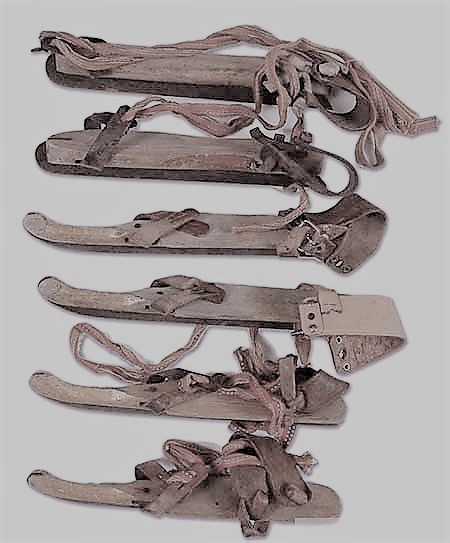What fascinated me to discover was that there is a belief that the earliest evidence of ice skating takes us to an era far more ancient than most people would reasonably expect. The excavation of Roman ruins of London, England from 50 B.C. uncovered leather soles and blades made from polished animal bones, which would make us consider the possibility that over 1000 years before Scandinavians wore skates made of deer or elk bones strapped to boots made of leather, people were skating on ice - even if it was just for transportation. Taking the origin of skating and skates even further back in time is the archaeological discovery of primitive animal bone ice skates on the banks of Lake Moss, Switzerland, dating back to 3000 B.C. - prehistoric times indeed. The first widely known written record of ice skating came in a book written by Canterbury monk William Fitzstephen, a cleric and administrator in the service of the murdered Archbishop Of Canterbury Thomas Becket (Saint Thomas Of Canterbury). His description of a scene within Canterbury city walls in the 1100's is as follows:
"...if the moors in Finsbury and Moorfield freeze over, children from London play. Some of the children have attached bones to their ankles, and carry well-worn sticks. They fly across the ice like birds, or well-fired arrows. Suddenly, two children will run at each other, sticks held high in the air. They then attack each other until one falls down. Often, the children injure their heads or break their arms or legs..."
Although these early documentations of recreational ice skating trace back to England in the 1100's, who is to confidently say that if these leather soles and blades were found in archaeological digs of ruins from 3000 B.C. or 50 B.C., that the use of these primitive skates wasn't just for transportation purposes? As long as people have lived on Earth, they have been amusing themselves with recreation and sport. In ancient China, there is evidence of ancient sporting activities such as gymnastics. Monuments to Egyptian Pharoahs depict swimming and fishing. Sports like polo, jousting and the Iranian martial art of Zourkhaneh have their origins in ancient Persia. Ancient Aztec cultures revelled in games like Ullamaliztli, Patolli and Totoloque. Tony Earll's research about Mu discusses the popularity of great tournaments like races, wrestling, stone-throwing and javelin, as well as a popular team ball-game. And, of course, ancient Greeks are well known for the importance that sport and recreation in their culture, having developed the Olympic Games, a tradition that exists to this day. If people to this day continue to amuse and entertain themselves by skating around in circles at public skating sessions, who's to say that in 3000 B.C. or 50 B.C. they weren't doing the same thing?
Were these people that we did not know personally merely trying to transport themselves over the ice or were they deriving some pleasure from the experience? The fact remains that we personally were not there. We don't truly know, and we won't truly necessarily ever know in this lifetime.
We do know that from some primitive origins, through England, through Scandinavia, Saint Lidwina, Jackson Haines, Austria, Russia, on ponds, frozen rivers and on lakes, skating slowly evolved into the activity, sport and art it is today. From mere transportation from point A to point B to games with sticks and bones to waltzing, figure eights and to the first jumps and spins on the ice, something was created that is beautiful to the eye and beautiful to the ice. Each and every figure skater who dared to be different has had their own hand in that.
Skating has grown to what is today, and it's bigger than a judging system that came into play following the 2002 Winter Olympics in Salt Lake City. We can't allow our memory or study to be that short sighted. It's going to continue to evolve and transform into something else, and then something else entirely, and then something else entirely again. Nothing is ever permanent. Our role as skaters, skating fans, judges, coaches, choreographers and lovers of the sport is to learn from each change but to remember that good skating is timeless. What we find beautiful about a grainy video of a performance from the 1940's is as beautiful as one from the 1960's, 1980's, 1995, 2007 or 2048. Beautiful skating transcends time, and now that we've discovered it, it's our responsibility to produce it, share it and cherish it.
Skate Guard is a blog dedicated to preserving the rich, colourful and fascinating history of figure skating. Over ten years, the blog has featured over a thousand free articles covering all aspects of the sport's history, as well as four compelling in-depth features. To read the latest articles, follow the blog on Facebook, Twitter, Pinterest and YouTube. If you enjoy Skate Guard, please show your support for this archive by ordering a copy of the figure skating reference books "The Almanac of Canadian Figure Skating", "Technical Merit: A History of Figure Skating Jumps" and "A Bibliography of Figure Skating": https://skateguard1.blogspot.com/p/buy-book.html.

